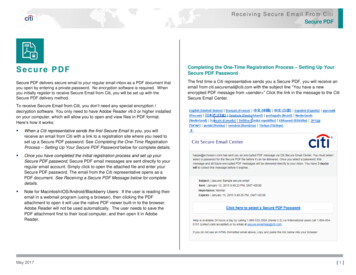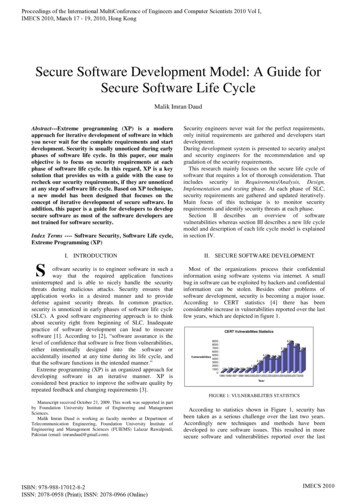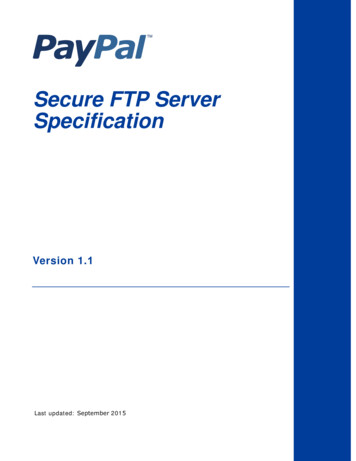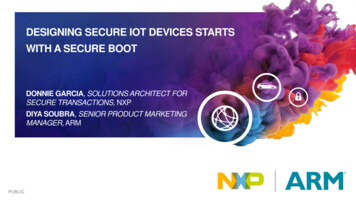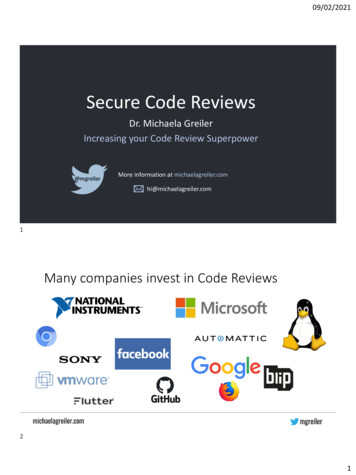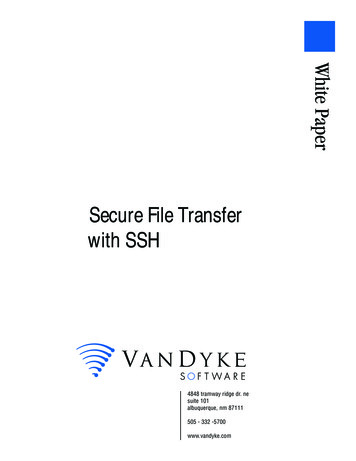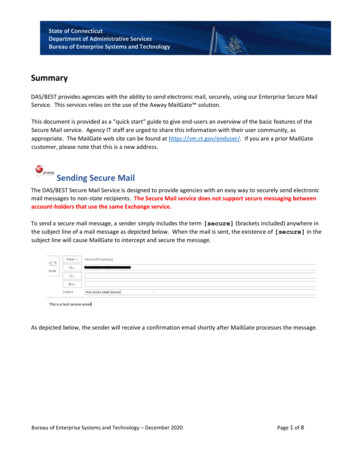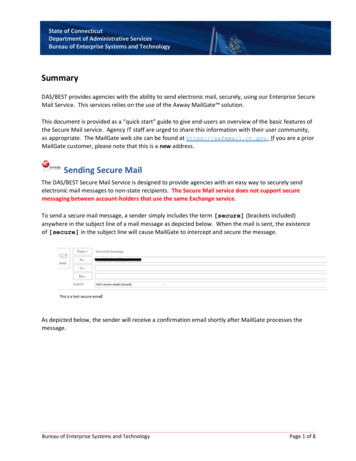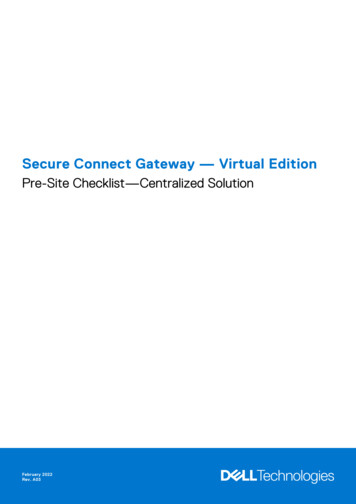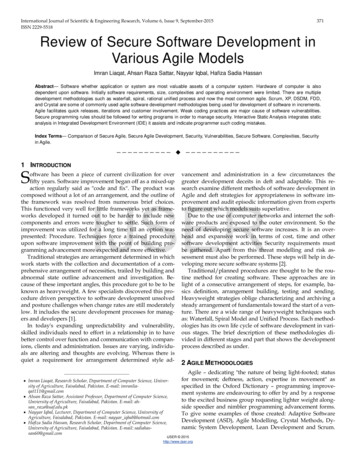
Transcription
International Journal of Scientific & Engineering Research, Volume 6, Issue 9, September-2015ISSN 2229-5518371Review of Secure Software Development inVarious Agile ModelsImran Liaqat, Ahsan Raza Sattar, Nayyar Iqbal, Hafiza Sadia HassanAbstract— Software whether application or system are most valuable assets of a computer system. Hardware of computer is alsodependent upon software. Initially software requirements, size, complexities and operating environment were limited. There are multipledevelopment methodologies such as waterfall, spiral, rational unified process and now the most common agile. Scrum, XP, DSDM, FDD,and Crystal are some of commonly used agile software development methodologies being used for development of software in increments.Agile facilitates quick releases, iterations and customer involvement. Weak coding practices are major cause of software vulnerabilities.Secure programming rules should be followed for writing programs in order to manage security. Interactive Static Analysis integrates staticanalysis in Integrated Development Environment (IDE) it assists and indicate programmer such coding mistakes.Index Terms— Comparison of Secure Agile, Secure Agile Development, Security, Vulnerabilities, Secure Software, Complexities, Securityin Agile.—————————— ——————————1 INTRODUCTIONSoftware has been a piece of current civilization for overfifty years. Software improvement began off as a mixed-upaction regularly said as "code and fix". The product wascomposed without a lot of an arrangement, and the outline ofthe framework was resolved from numerous brief choices.This functioned very well for little frameworks yet as frameworks developed it turned out to be harder to include newcomponents and errors were tougher to settle. Such form ofimprovement was utilized for a long time till an option waspresented: Procedure. Techniques force a trained procedureupon software improvement with the point of building programming advancement more expected and more effective.Traditional strategies are arrangement determined in whichwork starts with the collection and documentation of a comprehensive arrangement of necessities, trailed by building andabnormal state outline advancement and investigation. Because of these important angles, this procedure got to be to beknown as heavyweight. A few specialists discovered this procedure driven perspective to software development unsolvedand posture challenges when change rates are still moderatelylow. It includes the secure development processes for managers and developers [1].In today's expanding unpredictability and vulnerability,skilled individuals need to effort in a relationship in to havebetter control over function and communication with companions, clients and administration. Issues are varying, individuals are altering and thoughts are evolving. Whereas there isquiet a requirement for arrangement determined style ad-vancement and administration in a few circumstances thegreater development deceits in deft and adaptable. This research examine different methods of software development inAgile and deft strategies for appropriateness in software improvement and audit episodic information given from expertsto figure out which models suits superlative.Due to the use of computer networks and internet the software products are exposed to the outer environment. So theneed of developing secure software increases. It is an overhead and expansive work in terms of cost, time and othersoftware development activities Security requirements mustbe gathered. Apart from this threat modelling and risk assessment must also be performed. These steps will help in developing more secure software systems [2].Traditional/planned procedures are thought to be the routine method for creating software. These approaches are inlight of a consecutive arrangement of steps, for example, basics definition, arrangement building, testing and sending.Heavyweight strategies oblige characterizing and archiving asteady arrangement of fundamentals toward the start of a venture. There are a wide range of heavyweight techniques suchas: Waterfall, Spiral Model and Unified Process. Each methodologies has its own life cycle of software development in various stages. The brief description of these methodologies divided in different stages and part that shows the developmentprocess described as ——— Imran Liaqat, Research Scholar, Department of Computer Science, University of Agriculture, Faisalabad, Pakistan. E-mail: imranliaqat111@gmail.com Ahsan Raza Sattar, Assistant Professor, Department of Computer Science,Unviersity of Agriculture, Faisalabad, Pakistan. E-mail: ahsan raza@uaf.edu.pk Nayyar Iqbal, Lecturer, Department of Computer Science, University ofAgriculture, Faisalabad, Pakistan. E-mail: nayyar iqbal@hotmail.com Hafiza Sadia Hassan, Research Scholar, Department of Computer Science,University of Agriculture, Faisalabad, Pakistan. E-mail: sadiahassan60@gmail.com2 AGILE METHODOLOGIESAgile – dedicating "the nature of being light-footed; statusfor movement; deftness, action, expertise in movement" asspecified in the Oxford Dictionary – programming improvement systems are endeavouring to offer by and by a responseto the excited business group requesting lighter weight alongside speedier and nimbler programming advancement forms.To give some examples of those created: Adaptive SoftwareDevelopment (ASD), Agile Modelling, Crystal Methods, Dynamic System Development, Lean Development and Scrum.IJSER 2015http://www.ijser.org
International Journal of Scientific & Engineering Research, Volume 6, Issue 9, September-2015ISSN 2229-5518Every one of these philosophies recognized that astoundingprogramming and all the more vitally consumer loyalty couldjust be accomplished by bringing "delicacy" to their procedures.The old-style software development methodologies do notsupport daily changing requirements. These methodologiesare plan driven that are applied to small scale projects. Thesemethodologies are less flexible. Agile methods are flexible approaches that save time and cost. Agile methods are comfortable in managing constant changing requirements. These methods rely on strong customer communication between developers and customer. The basic rule of agile is to promote interactions, individuals, customer collaboration and comfort inchanging requirements [3].2.1 Extreme Programming (XP)Extreme programming (XP) has advanced after the issuescreated by the extended improvement phases of conventionaladvancement models. The XP procedure can be portrayed bylittle advancement phases, incremental arranging, nonstopinput, dependence on correspondence, and developmentaloutline. With all the overhead abilities, XP software engineersreact to moving environment through a great deal more bravery. Further as per Williams, XP colleagues expend couple ofminutes on programming, couple of minutes on venture administration, couple of minutes on configuration, couple ofminutes on criticism, and couple of minutes on group buildingordinarily every day. The expression "great" originates fromtaking these down to earth standards and observes to compelling stages.The extension of XP to facilitate developer team to elicit security requirements in a better way. It was seven steps resulted in threat scenarios and security functionalities. Most important goal of this method was proactive approach to security requirements and conduction of risk analysis. Security Sensitive Asset Identification, Threat Scenario (Abuse Case Stories) Formation, Risk Assessment of Abuser Scenarios, Negotiation of User & Abuser Stories, Defining Security Related UserStories, Defining Coding Standards for Security and Crossmatching of Abuser Stories were steps defined in this model[4].3722.3 Feature Driven Development (FDD)Feature Driven Development (FDD) was utilized interestingly as a part of the improvement of a substantial and complex managing an account application extend in the late90's.Unlike alternate systems, the FDD methodology does notprotection the whole software advancement transform butinstead spotlights on the configuration and building stages.The initial three stages are done toward the start of the venture. The previous two stages are the iterative piece of the procedure which bolsters the nimble improvement with speedyadjustments to late variations in necessities and businessneeds. The FDD methodology incorporates regular and unmistakable deliverables, alongside exact checking of the advancement of the report.The weak coding practices were most important cause ofsoftware vulnerabilities. Secure programming rules were followed for writing programs in order to manage security. Interactive Static Analysis integrated static analysis in IntegratedDevelopment Environment (IDE) it assisted and indicatedprogrammer such coding mistakes. If the coding did not rightdirection then the software cannot fulfil the requirements.2.4 Dynamic System Development Method (DSDM)The DSDM, Dynamic System Development Technique, wasproduced in the United Empire in the mid-1990. It is a mix of,and augmentation to, fast application improvement and Iterative advancement rehearses. Martin Fowler, one of the journalists of Agile Manifesto, accepts, "DSDM is remarkable for taking a great part of the foundation of more develop customarysystems, while taking after the standards of the nimble routines approach". The essential thought late DSDM is to altertime and assets, and afterward change the measure of usefulness in like manner as opposed to settling the measure of usefulness in an item, and after that conforming period and assetsto achieve that functionality.IJSER2.2 ScrumScrum is an iterative, incremental procedure for building upany item or dealing with some work. Scrum focuses on inwhat way the colleagues ought to capacity so as to create theframework adaptability in an always showing signs of changeenvironment. Toward the end of each emphasis it creates apossible arrangement of usefulness. The expression "scrum"began from a technique in the sport of rugger where it indicates "receiving an out-of-take care of business once again intothe diversion" with collaboration.Scrum does not oblige or give any particular programmingimprovement techniques/performs to be utilized. Rather, itinvolves certain administration practices and apparatuses indiverse periods of Scrum to keep away from the confusion byeccentrics and many-sided quality.3 SOFTWARE SECURITYSecurity is an extreme issue in building up any productitem. Much of the time the thought of what may happen if aproduct item is deliberately and vindictively assaulted, is disregarded. The product items nowadays are fragile to the pointthat they scarcely work appropriately when they have a primitive and predictable environment. At the point when nature,in which our product items run, gets to be forceful and noxious, the items fizzle drastically.Security engineering procedures bolster software improvement designing in conveying arrangements that anticipateabuse and vindictive conduct. The procedures enhance thefinished items security by including formal routines, prerequisites and predefined best practices for the designers. By having rules and solid steps the designers need to perform theprocedures tries to compel the engineers to concentrate onsecurity [5].Software Security Touch focuses has regularly been depictedas a lightweight security designing process that incorporatescentre exercises in a current advancement transform and enhances the quality and security part of the deciding item. BasicIJSER 2015http://www.ijser.org
International Journal of Scientific & Engineering Research, Volume 6, Issue 9, September-2015ISSN 2229-5518Criteria is develop and all around utilized security designingprimary that is ISO confirmed. Because of the utilization of PCsystems and web the product items are presented to the external environment. So the need of creating secure programmingincrements.4 SOFTWARE VULNERABILITIESVulnerabilities are a shortcoming in a product framework.Regularly, vulnerabilities have two conceivable roots, shortcomings in the execution of the product and imperfections inthe product's configuration. Nonetheless, source code basedvulnerabilities are still programming blames; the issues cansimply spread into a particular kind of disappointment, security weakness.Software improvement in disseminated dexterous systemdeveloping and dangers in such environment gets to be increment. Programming association was working in a tightconditions and very extreme environment. In conveyed lightfooted improvement numerous elements impact the sprygroup on the grounds that the partners and colleagues of advancement group scattered in diverse territories. Appropriated Agile Development (DAD) creates programming with easeand association changes the business necessities effortlessly[6].The idea of ahead of schedule helplessness location is likeright on time flaw recognition. The aim is to recognize anypeculiarity bringing about powerlessness in the item thatwould oblige push to be rectified after the item has been discharged to clients. Endeavours in recognizing a particularkind of defencelessness ought to additionally be engaged inthe stage and strategy that is most financially savvy for thatsort of helplessness. Studies in right on time shortcomingrecognition have demonstrated that distinguishing the deficiency prior being developed decreases the improvement cost.4.2 Implementation VulnerabilitiesAll product activities produce no less than one normal ancient rarity, the items' source code. At the code level, the emphasis is set on usage issues, particularly those that are noticeable by static investigation instruments. Nonetheless, knowingthe execution blames that are not distinguished is additionallyfascinating as it can be utilized to manage where other morecostly location systems ought to centre their examination on.4.3 Configuration VulnerabilitiesA completed item will in the end be conveyed on a client'ssystem. The setup of the item can be essential for security. Anitem that has been composed sheltered and executed effectively may at present be powerless because of for setup security.5 SECURE SOFTWARE DEVELOPMENT IN AGILEAgile advancement which is essentially iterated softwareimprovement strategy has been the plan for creating softwarefor various organizations amid the previous decade. The fastadvancement of software these days requires the rapid programming item conveyance by improvement groups. So as toconvey the item speedier, the advancement groups make achange from their customary software improvement lifecycleto light-footed improvement strategy which can empowerthem towards expedient conveyance of software adapting tothe prerequisites change marvel. As agile advancement concentrates on opportune conveyance of software, the securityissues and issues identified with that product marvel is notreally considered. These issues can make software items extraordinarily defenceless and inclined to malignant assaults bypeople.IJSERFig. 1. Origin and Propagation of Vulnerabilities4.1 Design VulnerabilitiesAt the point when planning an item it is conceivable to addprerequisites to the outline that would influence the finisheditems security. On such normal configuration helplessness isthe locking of clients after a foreordained measure of fizzledconfirmation endeavours. This prerequisite is frequentlynamed as a security necessity to avoid animal power secretkey speculating.3735.1 Secure Extreme Programming (SecureXP)The concentrate on distinguishing the security related practices of XP. Keeping in mind the end goal to set up satisfactorylevel of security inside of a framework, each XP part needs toreceive security centre practices as needs to decreasing thedangers or vulnerabilities.There are five fundamental parts in XP, i.e., Managers, mentor, client, designer, and the analyser. Likewise, we presentanother part "Security Maser". Each of the parts has his/herown particular security centre to verify that the product is created in secure way.Including some security components inside programming isnot viable if there is no expert individual in the improvementof secure programming. To verify the security issues are altered in fitting way, we included another part called "SecurityMaster" to give advices and lead different parts about securitydetails. Here, our examination concentrates on the action ofSecurity Master amid improvement [7].As said before that we present Security Master as anotherpart in XP who is master in security. This part gives a greatdeal of points of interest to XP group who needs to create secure programming utilizing XP hones. In XP, the part of security expert can be critical to give preparing to colleague, andsharing the data about sorts of assaults in diverse sorts of programming. Taking into account there are ten XP rehearsesIJSER 2015http://www.ijser.org
International Journal of Scientific & Engineering Research, Volume 6, Issue 9, September-2015ISSN 2229-5518which are arranging amusement, illustration, coding standard,straightforward outline, little discharge, ceaseless incorporation, pair programming, aggregate code proprietorship, 40hours every week and refactoring that are identified with security expert.374administrations taking into account client prerequisites and business sector request.The agile method resulted in rapid development, quick response to customer changing requirements, high degree of customer satisfaction and flexibility. But certain agile methodologieslike Scrum, XP and DSDM did not include security element inthem. This exclusion resulted in vulnerable software [9].Fig. 2. Extreme Programming Incorporating SecurityIJSER5.2 Secure Scrum (S-Scrum)Scrum disregards exact documentation of improvement exercises to build the advancement speed. Regardless this methodology contrarily influences the nature of the web administrationsthrough consolidating imprecision and absence of tractability intothe advancement process. Then again security as a quality property has dependably been a standout amongst the most essentialconcerns of the web administration improvement. To administerto security of the web administration we generally need to consolidate security investigation and outline into the improvementlife cycle. In spite of the fact that there have been a few endeavours to watch over examination exercises inside of the Scrumemphases, it is not clear yet how to accomplish this naturallythrough the Scrum forms. On alternate words watchful buildingof security into the general framework investigation and configuration is regularly dismissed. In this paper we propose a securityimproved form of scrum i.e. Secure Scrum (S-Scrum) to obligesecurity examination and configuration exercises inside of theScrum.To guarantee security of the web administrations it is obliged tointroduce stuffiest reports demonstrating fulfilment of securitygoals. Security certification is not legitimately upheld in Scrumbecause of the neglecting documentation of security contemplations and examination results. Dismissing the security documentation or de-underscoring on documentation initiates, is tranquildangerous in the setting of creating security basic framework [8].The significance of security is more substantial in terms of critical web administrations uncovered all around over the web.Scrum as a light-footed technique takes into account quick advancement of web administrations. Scrum likewise takes intoconsideration staying up to date with the changing prerequisitesamid the product improvement. Transformative nature of Scrumprocess likewise encourages incremental advancement of webFig. 3. Security in Scrum5.3 Secure Feature Driven Development (SFDD)Conventional agile software improvement practices considered that the genuine opponent to programming advancementprocedure is many-sided quality and size of the product. Thenagain, various late studies showed a more discriminating component disregarded by spry systems, i.e., software creating softwareproductively yet not safely has huge effects, for example, loss ofinformation, loss of notoriety, loss of clients' certainty etc. In thismanner, create secure programming in effective way, is a risingissue.Keeping in mind the end goal to address this issue the currentspry strategies should be returned to and improves so that theyIJSER 2015http://www.ijser.org
International Journal of Scientific & Engineering Research, Volume 6, Issue 9, September-2015ISSN 2229-5518TABLE 1COMPARISON OF AGILE METHODS3755.4 Secure Dynamic System Development Method(SDSDM)Agile models are referred to think working software as theessential measure of accomplishment, and don't pay consideration on security highlights. Clients' association in the task iscrucial in DSDM procedure model. Nonetheless, in its presentstructure, DSDM does exclude any specific part of securitypartners. In DSDM, there is unlucky deficiency of any stage orstages keeping in mind the end goal to cook the security issueswhile gathering/dissecting necessities, outlining, or actualizing of software.In the new SDSDM various changes were made: The firsttransform we made, present sub-stage in practical model emphasis called distinguish security concerns/issues which willprovide food for security exercise. Secondly, another stagewas presented called secure utilitarian model emphasis andeach of the sub stages security component is fused. Thirdly,secure configuration stage was presented in which securityissues are mapped to the stages with the goal that it will beensured against any vulnerabilities [11].In two-week iterations differing the objectives and goldentriangle for project. The author was using three different agilemethods XP, Scrum and DSDM to achieve the success factorand golden angel of the product. Agile team was using fourmethod of objective iteration like Schedule, Teem Satisfaction,Functionality and Quality [12].DSDM like other agile methods did not present any phasefor organization security. Dynamic System DevelopmentMethod was intended for organization in different changingrequirements. It compensated almost no notice to the securityrequirements. DSDM had purchaser involvement but no security master or security position. Analysis show if softwarewere organism developed by means of DSDM, they would notexist secure.IJSERcould give new stages, sub-stages, practices and parts identifiedwith secure programming advancement. As of late, we upgradedScrum show that could backing secure programming improvement. In the coherence of our examination, this paper concentrates on one of the coordinated advancement procedure, calledFeature Driven Development [10].Not at all like the In-Phase security, has the security viewpointbeen characterized after a stage, called After-Phase security. Forthis, we proposed two new stages, Build Security by Feature andTest Security by Feature. These stages are entirely suitable forexperienced and in addition new and less experienced group tocreate and test secure programming. Taking into account thesealterations, there are six stages out and out that begin with Develop an Overall Model, Build and Design Features, Build Security by Features, Plan by Features and Build by Features and TestSecurity by Features.Fig. 5. Secure Dynamic System Development Method6 COMPARISON OF VARIOUS SECURE AGILE METHODSFig. 4. Secure Feature Driven DevelopmentIJSER 2015http://www.ijser.org
International Journal of Scientific & Engineering Research, Volume 6, Issue 9, September-2015376ISSN 2229-5518[12] D. G. Firesmith, “Engineering Security Requirements,” The Journal of7 CONCLUSION AND FUTURE WORKObject Technology, vol. 2, pp. 53-68, 2003.According to table SFDD (Secure Feature Driven Development) is more complete method as compared to other methodfor developing secure software. This is because it covers largenumber of security management activities which are missingin other methods. It provides proper security planning andinvolves security risk analysis activities. It also considers security as important requirement and thus focuses on securityrequirement engineering activity. Security Modelling, Securecoding practices, security testing and use of security standardsmake it distinctive and effective.Performance of various agile methods for secure software development can be evaluated.ACKNOWLEDGMENTI would like to thank my parents, brothers, sisters, teachersand friends for praying, helping and motivating me throughout my educational career.REFERENCES[1]K. Gottipalla, N. M. S. Desai and M. S. Reddy, “Software Development Life Cycle Processes with Secure,” The International Journal ofScientific and Research Publications, vol. 3, pp. 1-3, 2013.[2] M. A. Hadavi, V. S. Hamishagi and H. M. Sangchi, “ Security Requirement Engineering; State of the Art and Research Challenges,”Proc. Int. Multi Conf. of Engineers and Computer Scientists, vol. 1, pp.19-22, 2008.[3] M. Almseidin, K. Alrfou, N. Alnidami and A. Tarawneh, “A Comparative Study of Agile Methods: XP and Scrum,” International Journal of Computer Science and Software Engineering, vol.4, no. 5, pp. 126129, 2015.[4] G. Bostrom, J. Wayrynen and M. Boden, “Extending XP Practices toSupport Requirements Engineering,” International Workshop SoftwareEngineering for Secure Systems, vol. 1, pp. 11-17, 2006.[5] P.Salini and S. Kanmani, “Survey and Analysis of Security Requirement Engineering,” The Journal of Computers and Electrical Engineering,vol. 38, pp. 1785-1797, 2012.[6] S. V. Shrivastava and U. Rathod, “Risks in distributed agile development A review,” Journal of Social and Behavioral Sciences, vol. 13, pp.417 – 424, 2014.[7] I. Ghani and I. Yasin, “Software Security Engineering in ExtremeProgramming Methodology: A Systematic Literature Review,” TheJournal of Sci.Int.(Lahore), vol. 25, pp. 215-22, 2013.[8] D. Mougouei, N. F. M. Sani and M. M. Almasi, “S-Scrum: a SecureMethodology for Agile Development of Web Services,” The World ofComputer Science and Information Technology Journal, vol. 3, pp. 15-19,2013.[9] C. B. Haley, R. Laney, J. D. Moffett and B. Nuseibeh, “Security Requirement Engineering: A Framework for Representation and Analysis,” IEEE Trans. on Software Engineering, vol. 34, pp. 133-153, 2008.[10] A. Firdaus, I. Ghani and S. R. Jeong, “Secure Feature Driven Development (SFDD) Model for Secure Software Development,” Int. Conf.on Innovation, Management and Technology Research, vol. 129, pp. 546553, 2013.[11] A. Sani and I. Ghani, “Secure Dynamic System Development Method(SDSDM) Model for Secure Software Development,” Journal ofSci.Int.(Lahore), vol.2, pp.1059-1064,2013.IJSERIJSER 2015http://www.ijser.org
development methodologies such as waterfall, spiral, rational unified process and now the most common agile. Scrum, XP, DSDM, FDD, and Crystal are some of commonly used agile software development methodologies being used for development of software in increments. Agile facilitates quick releases, iterations and customer involvement.
